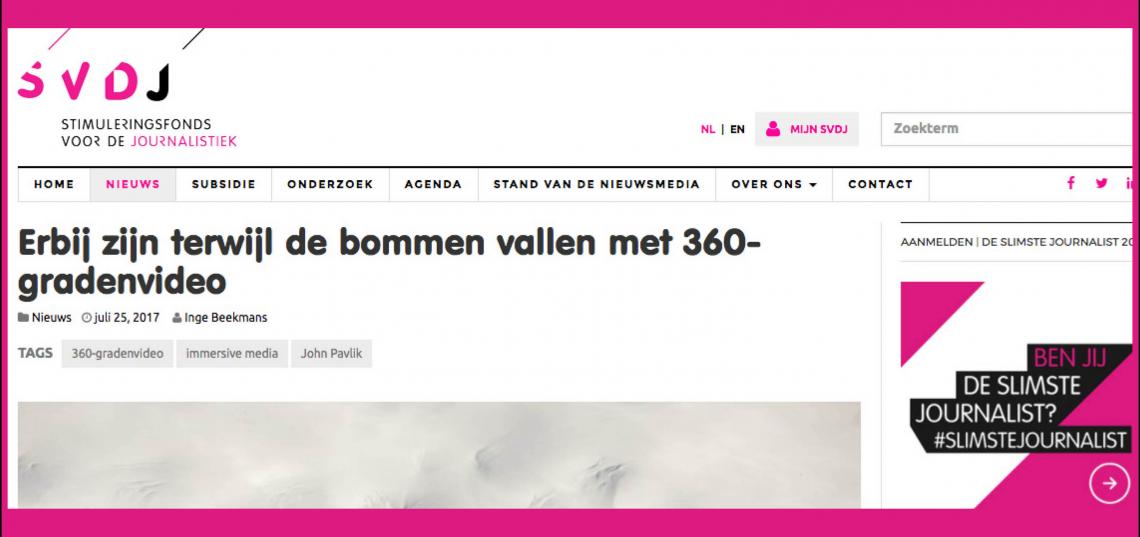
To read the article in Dutch, please click here.
Soon after the turn of the century, John Pavlik wondered whether 360 degree video could provide better journalism. Almost twenty years later, large media increasingly use this video technology. "360 degrees can empathize the audience."
Media professor John Pavlik has been researching ways for journalism to use new media and new techniques since the 90's. For one of his investigations , he worked on virtual reality production for a US crime news site.
"We brought people virtually to the place where a shooting took place, the audience could see where the bullet holes were," he says. "If you make a video or photo, you as a journalist usually determine the framework for that image. The viewer only sees what happens within that framework. That's a good way to focus the attention of the audience, but sometimes that focuses the context on and the reality. "
Welcome to the 21st century
There has been a lot of change since the 90's. The technique has gone a long way. Cameras have become smaller, better and faster, and millions of people have the ability to view 360-degree productions. "Now there is an increasing audience for this kind of productions, the interest of journalism grows," says Pavlik.
"I've seen a lot of good 360-degree videos, such as The New York Times , The Wallstreet Journal and The Guardian . Many of the videos they are currently making are short because the public has to get used to this new form. I expect that the videos will be longer in the future and more interaction will be possible. For example, the audience can walk in videos, free movement is currently not possible in most videos. "
At the explosion
Clàudia Prat makes videos for, among others, The New York Times Daily 360 . Also, she believes that 360 degrees video can provide extra context: "Because we can not frame the image , we always capture the entire event. This gives the audience the ability not only to look at the main event, but also to all other things that play around that main event. "
"When we make 360-degree videos, we often let the camera run at times that may not seem newsworthy, but quite commonplace. The reality, and thus 'the truth', lies in those kinds of moments, "explains Prat. " Maya Alleruzzo filmed a living room where journalists and family sat when a very big explosion occurred very close. Thus she managed to capture the explosion and capture everyone's reaction to the explosion. This is how everyday life for families in Mosul looked like. "
Pavlik speaks when it's about 360 degree video and virtual reality about 'immersive media', narrative forms that immerse the audience , for example in a video or game. According to the academic, one of the main differences between these narrative forms and traditional media is that the public's perspective changes. "In the traditional approach, journalists tell a story from the third person," he says. "In a 360 degree video, you give the viewer a first-person perspective. Viewing the situation from that perspective can generate feelings of empathy with the public. This way, thanks to these new video technologies, you can see the life of a refuge through the eyes of a refugee. "
"Journalism in virtual reality can be terribly powerful thanks to that new perspective," believes Pavlik. One of his favorite examples for immersive storytelling is The Antarctica Series of The New York Times. "How many people get the chance to go to Antarctica? Almost nobody, "he argues. "Yet, it is a very important topic. Antarctica can show us things about climate change, global warming and the rise of the sea level. The production of The New York Times gives the viewer the chance to experience what they could never have seen in this way without this journalistic production. "
Whether this results in better journalism? Pavlik does not believe journalism is getting better automatically thanks to new techniques. However, he thinks that immersive techniques allow journalists to add an additional context to a story and involve the viewer more in a story. "These types of videos can be very engaging, a good 360 degree video just do not forget about you."
